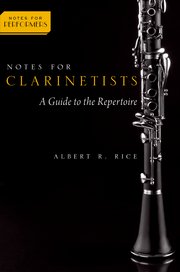
OXFORD UNIVERSITY PRESS - 19
Notes for Clarinetists - A Guide to the Repertoire
Composer:
Publisher:
Instrument:
Notes for Clarinetists - A Guide to the Repertoire
Juilliard Store
144 West 66th Street
New York NY 10023
United States
by Albert R Rice
Notes for Clarinetists: A Guide to the Repertoire offers important historical and analytical information about thirty-five of the best-known pieces written for the instrument. Numerous contextual and theoretical insights make it an essential resource for professional, amateur, and student clarinetists. With engaging prose supported by fact-filled analytical charts, the book offers rich biographical information and informative analyses to help clarinetists gain a more complete understanding of Three Pieces for Clarinet Solo by Igor Stravinsky, Aaron Copland's Concerto for Clarinet, String Orchestra, Harp, and Piano, Robert Schumann's Fantasy Pieces for Clarinet and Piano, Op. 73. and Time Pieces for Clarinet and Piano, Op. 43. by Robert Muczynski, among many others.
Table of Contents:
Chapter 1 Arthur Benjamin, Le Tombeau de Ravel Valse-Caprices for clarinet and piano
Chapter 2 Alban Berg, Four pieces for clarinet and piano, op. 5
Chapter 3 Luciano Berio, Sequenza IXa for clarinet solo
Chapter 4 Leonard Bernstein, Sonata for clarinet and piano
Chapter 5 Pierre Boulez, Domaines for clarinet alone
Chapter 6 Johannes Brahms, Sonata for clarinet and piano, op. 120, no. 1
Chapter 7 Aaron Copland, Concerto for clarinet, string orchestra, harp, and piano
Chapter 8 Bernhard Henrik Crusell, Concerto for clarinet and orchestra, op. 5
Chapter 9 Claude Debussy, Première Rhapsodie for clarinet and piano
Chapter 10 Gerald Finzi, Five Bagatelles for clarinet and piano, op. 23
Chapter 11 Jean Françaix, Concerto for clarinet and orchestra
Chapter 12 Paul Hindemith, Sonata for clarinet and piano
Chapter 13 Franz Krommer, Concerto for clarinet and orchestra, op. 36
Chapter 14 Jean-Xavier Lefèvre, Sonata for clarinet and bass, op. 12, no. 1
Chapter 15 Witold Lutosawski, Dance Preludes for clarinet and piano
Chapter 16 Donald Martino, A set for clarinet unaccompanied
Chapter 17 Bohuslav Martinu, Sonatina for clarinet and piano
Chapter 18 Darius Milhaud, Sonatina for clarinet and piano, op. 100
Chapter 19 Wolfgang Amadeus Mozart, Concerto for clarinet and orchestra, K. 622
Chapter 20 Robert Muczynski, Time pieces for clarinet and piano, op. 43
Chapter 21 Carl Nielsen, Concerto for clarinet and orchestra, op. 57
Chapter 22 Krzysztof Penderecki, Three miniatures for clarinet and piano
Chapter 23 Francis Poulenc, Sonata for clarinet and piano
Chapter 24 Max Reger, Sonata for clarinet and piano, op. 107
Chapter 25 Gioachino Rossini, Introduction, theme & variations for clarinet & orchestra
Chapter 26 Archduke Rudolph of Austria, Sonata for clarinet and piano, op. 2
Chapter 27 Camille Saint-Saëns, Sonata for clarinet and piano, op. 162
Chapter 28 Robert Schumann, Fantasy pieces for clarinet and piano, op. 73
Chapter 29 William O. Smith, Variants for solo clarinet
Chapter 30 Louis Spohr, Concerto for clarinet and orchestra, op. 26
Chapter 31 Johann Stamitz, Concerto for clarinet and orchestra
Chapter 32 Karlheinz Stockhausen, Der Kleine Harlekin für Klarinette, Werk Nr. 42½
Chapter 33 Igor Stravinsky, Three pieces for clarinet solo
Chapter 34 Antoni Szalowki, Sonatina for clarinet and piano
Chapter 35 Carl Maria von Weber, Grand duo concertant for clarinet and piano, op. 48
Bibliography
Index
With close attention to matters of context, style, and harmonic and formal analysis, Albert Rice explores a significant portion of the repertoire, and offers a faithful and comprehensive guide that includes works by Boulez, Brahms, and Mozart to Hindemith, Poulenc, and Stamitz. Rice includes biographical information on each composer and highlights history's impact on the creation and performance of important works for clarinet.
Intended as a starting point for connecting performance studies with scholarship, Rice's analysis will help clarinetists gain a more complete picture of a given work. Its valuable insights make it essential to musicians preparing and presenting programs, and its detailed historical information about the work and composer will encourage readers to explore other works in a similarly analytical way. Covering concertos, chamber pieces, and works for solo clarinet, Rice presents Notes for Clarinetists as an indispensable handbook for students and professionals alike.

